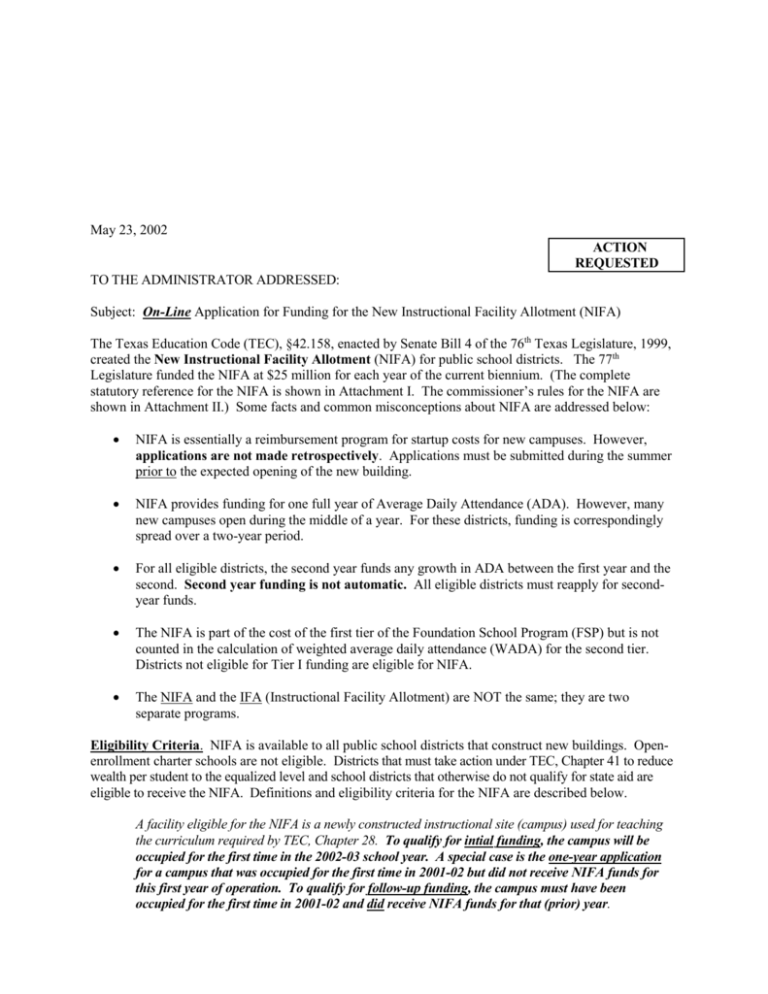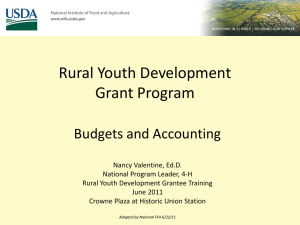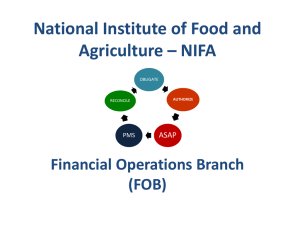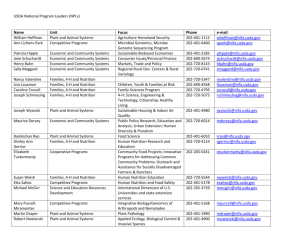ATTACHMENT I - Texas Education Agency
advertisement

May 23, 2002 ACTION REQUESTED TO THE ADMINISTRATOR ADDRESSED: Subject: On-Line Application for Funding for the New Instructional Facility Allotment (NIFA) The Texas Education Code (TEC), §42.158, enacted by Senate Bill 4 of the 76th Texas Legislature, 1999, created the New Instructional Facility Allotment (NIFA) for public school districts. The 77th Legislature funded the NIFA at $25 million for each year of the current biennium. (The complete statutory reference for the NIFA is shown in Attachment I. The commissioner’s rules for the NIFA are shown in Attachment II.) Some facts and common misconceptions about NIFA are addressed below: NIFA is essentially a reimbursement program for startup costs for new campuses. However, applications are not made retrospectively. Applications must be submitted during the summer prior to the expected opening of the new building. NIFA provides funding for one full year of Average Daily Attendance (ADA). However, many new campuses open during the middle of a year. For these districts, funding is correspondingly spread over a two-year period. For all eligible districts, the second year funds any growth in ADA between the first year and the second. Second year funding is not automatic. All eligible districts must reapply for secondyear funds. The NIFA is part of the cost of the first tier of the Foundation School Program (FSP) but is not counted in the calculation of weighted average daily attendance (WADA) for the second tier. Districts not eligible for Tier I funding are eligible for NIFA. The NIFA and the IFA (Instructional Facility Allotment) are NOT the same; they are two separate programs. Eligibility Criteria. NIFA is available to all public school districts that construct new buildings. Openenrollment charter schools are not eligible. Districts that must take action under TEC, Chapter 41 to reduce wealth per student to the equalized level and school districts that otherwise do not qualify for state aid are eligible to receive the NIFA. Definitions and eligibility criteria for the NIFA are described below. A facility eligible for the NIFA is a newly constructed instructional site (campus) used for teaching the curriculum required by TEC, Chapter 28. To qualify for intial funding, the campus will be occupied for the first time in the 2002-03 school year. A special case is the one-year application for a campus that was occupied for the first time in 2001-02 but did not receive NIFA funds for this first year of operation. To qualify for follow-up funding, the campus must have been occupied for the first time in 2001-02 and did receive NIFA funds for that (prior) year. The facility must have its own principal or be eligible to receive an accountability rating through standard analysis as described in the most current Accountability Manual. The facility must have its own campus ID number as designated by the Texas Education Agency, and its own record of expenditures that is not a sub-set of another school budget, and attendance data that can be reported for those students who are assigned to its campus. With the exception of a covered walkway connecting the new facility to another building, the new facility must be physically separate from other existing school structures. It must have its own assigned instructional staff and instructional program distinct from other facilities. It cannot be a program for students enrolled in another public school (summer school, evening school, etc.). Expansion or renovation of existing facilities, as well as portable and temporary structures, are not eligible for the NIFA. Renovations, no matter how extensive, will not qualify for NIFA funds unless the building is completely new from the ground-up, including the slab. The only exception would be a campus with newly constructed instructional space and renovated or retained non-instructional structures, such as cafeteria or library. Allotment Amount. For an initial (first-time) application, a school district is entitled to an allotment of $250 for each student in average daily attendance (ADA) at the facility. This means that ADA is reduced for a facility that opens after the beginning of the school year. For follow-up (second-year) applications, a district is entitled to an allotment of $250 for each additional student in ADA. The number of additional students is the difference between the number of students in ADA in the current year at that facility and the number in the preceding year. Allotment Proration. The amount appropriated for NIFA is limited to $25 million for a school year. If the total amount of allotments to which all districts combined are entitled for a school year exceeds the amount appropriated, the commissioner will reduce each district’s allotment so that the total amount to be distributed equals the amount available. Reductions to allotments are made by applying the same number of cents of tax rate to each district’s taxable value of property. For each district, the taxable value of property is the property value certified by the Comptroller for the preceding school year as determined under Subchapter M, Chapter 403, Government Code, or, if applicable, a reduced property value that reflects either a rapid decline pursuant to TEC §42.2521 or a grade level adjustment pursuant to TEC §42.106. Application Process. The NIFA application is now available on-line. Applications must be entered, saved, and submitted to the online system by July 15th The due date is firm. No late applications will be accepted, nor will paper submissions. The on-line system requires a logon and assigned password for the new automated Foundation School Program system. Once entered into the system, the user should choose “NIFA” from the menu options and fill in the requested information. If you have questions, consult the school finance specialist at your regional service center or telephone Gail Nelson, the person noted below. Please note that the system will not process an application until the applicant agrees (verifies) that certain required conditions apply to the newly constructed site. Moreover, the system assumes that the applicant is the superintendent or the superintendent’s designee and is fully familiar with the pertinent facts. Please be cautious about who is granted on-line access, as the information to which the applicant agrees is subject to audit. An initial application applies to a facility not occupied prior to the 2002-03 school year and which has never before received NIFA funds. A one-year application is a special case of an initial application and pertains to a facility first occupied in 2001-02 but not receiving NIFA funds for that year because of failure to apply. In addition to the information to be completed on-line, an initial or one-year application must include a photograph of the newly built campus and minimal documentation regarding its construction. It is recommended that this information be submitted by certified mail through the U.S. Postal Service or other common postal carrier, although this is not required. It is also recommended that the documentation be kept brief (such as a copy of a contract, certification of project compliance, or certification of substantial completion). These documents should be sent to the following address: Texas Education Agency School Finance and Fiscal Analysis, 6-120 Attention: NIFA 1701 North Congress Avenue Austin, TX 78701-1494 A follow-up application is for a facility not occupied prior to the 2001-02 school year and receiving NIFA funding last year. Funding for the second year is based on the number of students in ADA as compared to the first year. Preliminary Payments. Because many NIFA applications are for a second year (follow-up), and the amount of funding to which such districts are entitled depends in part on the ADA funded in the prior year, it is necessary to finalize allocations for the prior year before applications can be processed for the current year. Since end-of-year 2001-02 ADA data from the Public Education Management System (PEIMS) are not available until October, preliminary NIFA amounts will not be computed until November or later. A separate NIFA check will not be sent. Rather, preliminary payments will be incorporated into allocations for the Foundation School Program in accordance with the district’s payment class. NIFA costs are reflected on the Summary of Finance reports. For districts that are not subject to the requirements of Chapter 41 and do not receive payments from the Foundation School Fund, NIFA distributions will correspond to the schedule for payment class 3. For districts that are required to reduce wealth pursuant to TEC, Chapter 41, any NIFA funds for which the district is eligible are applied as credits to the amounts owed to equalize wealth. For all districts receiving the NIFA, a final (settle-up) amount is determined by the commissioner when final counts of ADA as reported through PEIMS are available for each eligible campus, at the close of business for the school year. The amount of funds to be distributed for the NIFA to a school district is in addition to any other state aid entitlements. Contact Person. If you have any questions related to any of this information, please contact Gail Nelson in the School Finance and Fiscal Analysis Department at 512/463-8994. Sincerely, Joe Wisnoski, Associate Commissioner School Finance and Fiscal Analysis Attachment I STATUTORY CITATIONS RELATING TO NEW INSTRUCTIONAL FACILITY ALLOTMENT §42.158. NEW INSTRUCTIONAL FACILITY ALLOTMENT (a) A school district is entitled to an additional allotment as provided by this section for operational expenses associated with opening a new instructional facility. (b) For the first school year in which students attend a new instructional facility, a school district is entitled to an allotment of $250 for each student in average daily attendance at the facility. For the second school year in which students attend that instructional facility, a school district is entitled to an allotment of $250 for each additional student in average daily attendance at the facility. (c) For purposes of this section, the number of additional students in average daily attendance at a facility is the difference between the number of students in average daily attendance in the current year at that facility and the number of students in average daily attendance at the facility in the preceding year. (d) The amount appropriated for allotments under this section may not exceed $25 million in a school year. If the total amount of allotments to which districts are entitled under this section for a school year exceeds the amount appropriated for allotments under this section, the commissioner shall reduce each district’s allotment under this section in the manner provided by §42.253(h). (e) A school district that is required to take action under Chapter 41 to reduce its wealth per student to the equalized wealth level is entitled to a credit, in the amount of the allotments to which the district is entitled under this section, against the total amount required under §41.093 for the district to purchase attendance credits. A school district that is otherwise ineligible for state aid under this chapter is entitled to receive allotments under this section. (f) The commissioner may adopt rules necessary to implement this section. (g) In this section, “instructional facility” has the meaning assigned by §46.001. ATTACHMENT II Text of Adopted New 19 TAC Chapter 61. School Districts Subchapter CC. Commissioner's Rules Concerning School Facilities. §61.1034. New Instructional Facility Allotment. (a) (b) Definitions and eligibility. The following definitions and eligibility criteria apply to the new instructional facility allotment (NIFA) in accordance with Texas Education Code (TEC), §42.158. (1) A facility eligible for the NIFA is a newly constructed instructional site (campus), not occupied prior to the 1999-2000 school year, used for teaching the curriculum required by TEC, Chapter 28. (2) The facility must have its own principal, or be eligible to receive an accountability rating through standard analysis as described in the most current Accountability Manual. (3) The facility must have its own campus ID number as designated by the Texas Education Agency (TEA), and its own record of expenditures that is not a subset of another school budget, and attendance data that can be reported for those students who are assigned to its campus. (4) With the exception of a covered walkway connecting the new facility to another building, the new facility must be physically separate from other existing school structures. (5) The facility must have its own assigned instructional staff and instructional program distinct from other facilities, and cannot be a program for students enrolled in another public school (summer school, evening school, etc.). (6) Expansion or renovation of existing facilities, as well as portable and temporary structures, are not eligible for the NIFA. Application process. School districts must complete an application process requesting funding pursuant to the NIFA. (1) (c) The initial (first-year) application must include the following: (A) a written request for funds; (B) a brief description and photograph of the newly constructed instructional site; (C) a copy of contracts that document the nature and dates of the construction; and (D) an estimate of the number of students in average daily attendance (ADA). (2) For the 1999-2000 school year, applications must be postmarked by the last day in December in order to qualify for the allotment. For school years beginning with 2000-2001, applications must be postmarked by July 15. (3) All applications must be submitted to the TEA by certified mail through the U.S. Postal Service or other common postal carrier. (4) Second-year applications require only the submission of an estimate of students in ADA. Costs and payments. The cost and payments for the NIFA are determined by the commissioner of education. (1) The allotment for the NIFA is a part of the cost of the first tier of the Foundation School Program (FSP). This allotment is not counted in the calculation of weighted average daily attendance (WADA) for the second tier of the FSP. (2) If, for all eligible districts combined, the total cost of the NIFA exceeds the amount appropriated, each allotment is reduced so that the total amount to be distributed equals the amount appropriated. Reductions to allotments are made by applying the same number of cents of tax rate in each district to the district's taxable value of property so that the reduced total for all districts equals the amount appropriated. For each district, the taxable value of property is the property value certified by the Comptroller of Public Accounts for the preceding school year as determined under Government Code, Chapter 403, Subchapter M, or, if applicable, a reduced property value that reflects either a rapid decline pursuant to TEC, §42.2521, or a grade level adjustment pursuant to TEC, §42.106. (3) For the 1999-2000 school year, districts not subject to the requirements of wealth equalization pursuant to TEC, Chapter 41, will begin receiving payments of the NIFA in January based on the estimate of ADA submitted in the funding application. For the remainder of 1999-2000 and for subsequent years, allocations will be made in conjunction with allotments for the FSP in accordance with the district's payment class. For districts that are not subject to the requirements of TEC, Chapter 41, and do not receive payments from the Foundation School Fund, NIFA distributions will correspond to the schedule for payment class 3. (4) For districts that are required to reduce wealth pursuant to TEC, Chapter 41, any NIFA funds for which the district is eligible are applied as credits to the amounts owed to equalize wealth. (5) For all districts receiving the NIFA, a final (settle-up) amount earned is determined by the commissioner when final counts of ADA as reported through the Public Education Information Management System (PEIMS) are available for the eligible campus, at the close of business for the school year. (6) The amount of funds to be distributed for the NIFA to a school district is in addition to any other state aid entitlements.









